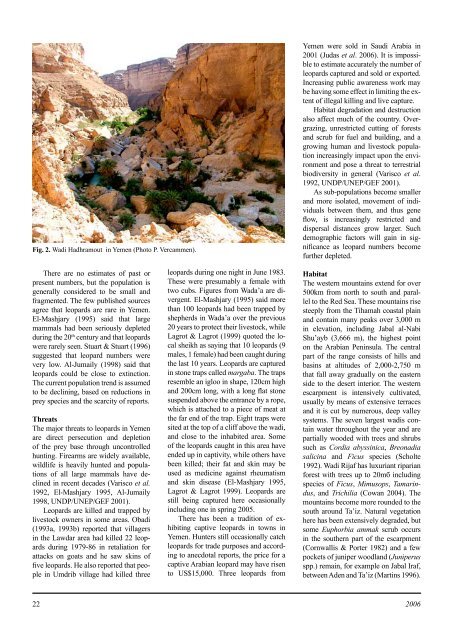Status and Conservation of the Leopard on the Arabian Peninsula ...
Status and Conservation of the Leopard on the Arabian Peninsula ...
Status and Conservation of the Leopard on the Arabian Peninsula ...
Create successful ePaper yourself
Turn your PDF publications into a flip-book with our unique Google optimized e-Paper software.
Fig. 2. Wadi Hadhramout in Yemen (Photo P. Vercammen).<br />
There are no estimates <str<strong>on</strong>g>of</str<strong>on</strong>g> past or<br />
present numbers, but <str<strong>on</strong>g>the</str<strong>on</strong>g> populati<strong>on</strong> is<br />
generally c<strong>on</strong>sidered to be small <str<strong>on</strong>g>and</str<strong>on</strong>g><br />
fragmented. The few published sources<br />
agree that leopards are rare in Yemen.<br />
El-Mashjary (1995) said that large<br />
mammals had been seriously depleted<br />
during <str<strong>on</strong>g>the</str<strong>on</strong>g> 20 th century <str<strong>on</strong>g>and</str<strong>on</strong>g> that leopards<br />
were rarely seen. Stuart & Stuart (1996)<br />
suggested that leopard numbers were<br />
very low. Al-Jumaily (1998) said that<br />
leopards could be close to extincti<strong>on</strong>.<br />
The current populati<strong>on</strong> trend is assumed<br />
to be declining, based <strong>on</strong> reducti<strong>on</strong>s in<br />
prey species <str<strong>on</strong>g>and</str<strong>on</strong>g> <str<strong>on</strong>g>the</str<strong>on</strong>g> scarcity <str<strong>on</strong>g>of</str<strong>on</strong>g> reports.<br />
Threats<br />
The major threats to leopards in Yemen<br />
are direct persecuti<strong>on</strong> <str<strong>on</strong>g>and</str<strong>on</strong>g> depleti<strong>on</strong><br />
<str<strong>on</strong>g>of</str<strong>on</strong>g> <str<strong>on</strong>g>the</str<strong>on</strong>g> prey base through unc<strong>on</strong>trolled<br />
hunting. Firearms are widely available,<br />
wildlife is heavily hunted <str<strong>on</strong>g>and</str<strong>on</strong>g> populati<strong>on</strong>s<br />
<str<strong>on</strong>g>of</str<strong>on</strong>g> all large mammals have declined<br />
in recent decades (Varisco et al.<br />
1992, El-Mashjary 1995, Al-Jumaily<br />
1998, UNDP/UNEP/GEF 2001).<br />
<str<strong>on</strong>g>Leopard</str<strong>on</strong>g>s are killed <str<strong>on</strong>g>and</str<strong>on</strong>g> trapped by<br />
livestock owners in some areas. Obadi<br />
(1993a, 1993b) reported that villagers<br />
in <str<strong>on</strong>g>the</str<strong>on</strong>g> Lawdar area had killed 22 leopards<br />
during 1979-86 in retaliati<strong>on</strong> for<br />
attacks <strong>on</strong> goats <str<strong>on</strong>g>and</str<strong>on</strong>g> he saw skins <str<strong>on</strong>g>of</str<strong>on</strong>g><br />
five leopards. He also reported that people<br />
in Umdrib village had killed three<br />
leopards during <strong>on</strong>e night in June 1983.<br />
These were presumably a female with<br />
two cubs. Figures from Wada’a are divergent.<br />
El-Mashjary (1995) said more<br />
than 100 leopards had been trapped by<br />
shepherds in Wada’a over <str<strong>on</strong>g>the</str<strong>on</strong>g> previous<br />
20 years to protect <str<strong>on</strong>g>the</str<strong>on</strong>g>ir livestock, while<br />
Lagrot & Lagrot (1999) quoted <str<strong>on</strong>g>the</str<strong>on</strong>g> local<br />
sheikh as saying that 10 leopards (9<br />
males, 1 female) had been caught during<br />
<str<strong>on</strong>g>the</str<strong>on</strong>g> last 10 years. <str<strong>on</strong>g>Leopard</str<strong>on</strong>g>s are captured<br />
in st<strong>on</strong>e traps called margaba. The traps<br />
resemble an igloo in shape, 120cm high<br />
<str<strong>on</strong>g>and</str<strong>on</strong>g> 200cm l<strong>on</strong>g, with a l<strong>on</strong>g flat st<strong>on</strong>e<br />
suspended above <str<strong>on</strong>g>the</str<strong>on</strong>g> entrance by a rope,<br />
which is attached to a piece <str<strong>on</strong>g>of</str<strong>on</strong>g> meat at<br />
<str<strong>on</strong>g>the</str<strong>on</strong>g> far end <str<strong>on</strong>g>of</str<strong>on</strong>g> <str<strong>on</strong>g>the</str<strong>on</strong>g> trap. Eight traps were<br />
sited at <str<strong>on</strong>g>the</str<strong>on</strong>g> top <str<strong>on</strong>g>of</str<strong>on</strong>g> a cliff above <str<strong>on</strong>g>the</str<strong>on</strong>g> wadi,<br />
<str<strong>on</strong>g>and</str<strong>on</strong>g> close to <str<strong>on</strong>g>the</str<strong>on</strong>g> inhabited area. Some<br />
<str<strong>on</strong>g>of</str<strong>on</strong>g> <str<strong>on</strong>g>the</str<strong>on</strong>g> leopards caught in this area have<br />
ended up in captivity, while o<str<strong>on</strong>g>the</str<strong>on</strong>g>rs have<br />
been killed; <str<strong>on</strong>g>the</str<strong>on</strong>g>ir fat <str<strong>on</strong>g>and</str<strong>on</strong>g> skin may be<br />
used as medicine against rheumatism<br />
<str<strong>on</strong>g>and</str<strong>on</strong>g> skin disease (El-Mashjary 1995,<br />
Lagrot & Lagrot 1999). <str<strong>on</strong>g>Leopard</str<strong>on</strong>g>s are<br />
still being captured here occasi<strong>on</strong>ally<br />
including <strong>on</strong>e in spring 2005.<br />
There has been a traditi<strong>on</strong> <str<strong>on</strong>g>of</str<strong>on</strong>g> exhibiting<br />
captive leopards in towns in<br />
Yemen. Hunters still occasi<strong>on</strong>ally catch<br />
leopards for trade purposes <str<strong>on</strong>g>and</str<strong>on</strong>g> according<br />
to anecdotal reports, <str<strong>on</strong>g>the</str<strong>on</strong>g> price for a<br />
captive <strong>Arabian</strong> leopard may have risen<br />
to US$15,000. Three leopards from<br />
Yemen were sold in Saudi Arabia in<br />
2001 (Judas et al. 2006). It is impossible<br />
to estimate accurately <str<strong>on</strong>g>the</str<strong>on</strong>g> number <str<strong>on</strong>g>of</str<strong>on</strong>g><br />
leopards captured <str<strong>on</strong>g>and</str<strong>on</strong>g> sold or exported.<br />
Increasing public awareness work may<br />
be having some effect in limiting <str<strong>on</strong>g>the</str<strong>on</strong>g> extent<br />
<str<strong>on</strong>g>of</str<strong>on</strong>g> illegal killing <str<strong>on</strong>g>and</str<strong>on</strong>g> live capture.<br />
Habitat degradati<strong>on</strong> <str<strong>on</strong>g>and</str<strong>on</strong>g> destructi<strong>on</strong><br />
also affect much <str<strong>on</strong>g>of</str<strong>on</strong>g> <str<strong>on</strong>g>the</str<strong>on</strong>g> country. Overgrazing,<br />
unrestricted cutting <str<strong>on</strong>g>of</str<strong>on</strong>g> forests<br />
<str<strong>on</strong>g>and</str<strong>on</strong>g> scrub for fuel <str<strong>on</strong>g>and</str<strong>on</strong>g> building, <str<strong>on</strong>g>and</str<strong>on</strong>g> a<br />
growing human <str<strong>on</strong>g>and</str<strong>on</strong>g> livestock populati<strong>on</strong><br />
increasingly impact up<strong>on</strong> <str<strong>on</strong>g>the</str<strong>on</strong>g> envir<strong>on</strong>ment<br />
<str<strong>on</strong>g>and</str<strong>on</strong>g> pose a threat to terrestrial<br />
biodiversity in general (Varisco et al.<br />
1992, UNDP/UNEP/GEF 2001).<br />
As sub-populati<strong>on</strong>s become smaller<br />
<str<strong>on</strong>g>and</str<strong>on</strong>g> more isolated, movement <str<strong>on</strong>g>of</str<strong>on</strong>g> individuals<br />
between <str<strong>on</strong>g>the</str<strong>on</strong>g>m, <str<strong>on</strong>g>and</str<strong>on</strong>g> thus gene<br />
flow, is increasingly restricted <str<strong>on</strong>g>and</str<strong>on</strong>g><br />
dispersal distances grow larger. Such<br />
demographic factors will gain in significance<br />
as leopard numbers become<br />
fur<str<strong>on</strong>g>the</str<strong>on</strong>g>r depleted.<br />
Habitat<br />
The western mountains extend for over<br />
500km from north to south <str<strong>on</strong>g>and</str<strong>on</strong>g> parallel<br />
to <str<strong>on</strong>g>the</str<strong>on</strong>g> Red Sea. These mountains rise<br />
steeply from <str<strong>on</strong>g>the</str<strong>on</strong>g> Tihamah coastal plain<br />
<str<strong>on</strong>g>and</str<strong>on</strong>g> c<strong>on</strong>tain many peaks over 3,000 m<br />
in elevati<strong>on</strong>, including Jabal al-Nabi<br />
Shu’ayb (3,666 m), <str<strong>on</strong>g>the</str<strong>on</strong>g> highest point<br />
<strong>on</strong> <str<strong>on</strong>g>the</str<strong>on</strong>g> <strong>Arabian</strong> <strong>Peninsula</strong>. The central<br />
part <str<strong>on</strong>g>of</str<strong>on</strong>g> <str<strong>on</strong>g>the</str<strong>on</strong>g> range c<strong>on</strong>sists <str<strong>on</strong>g>of</str<strong>on</strong>g> hills <str<strong>on</strong>g>and</str<strong>on</strong>g><br />
basins at altitudes <str<strong>on</strong>g>of</str<strong>on</strong>g> 2,000-2,750 m<br />
that fall away gradually <strong>on</strong> <str<strong>on</strong>g>the</str<strong>on</strong>g> eastern<br />
side to <str<strong>on</strong>g>the</str<strong>on</strong>g> desert interior. The western<br />
escarpment is intensively cultivated,<br />
usually by means <str<strong>on</strong>g>of</str<strong>on</strong>g> extensive terraces<br />
<str<strong>on</strong>g>and</str<strong>on</strong>g> it is cut by numerous, deep valley<br />
systems. The seven largest wadis c<strong>on</strong>tain<br />
water throughout <str<strong>on</strong>g>the</str<strong>on</strong>g> year <str<strong>on</strong>g>and</str<strong>on</strong>g> are<br />
partially wooded with trees <str<strong>on</strong>g>and</str<strong>on</strong>g> shrubs<br />
such as Cordia abyssinica, Bre<strong>on</strong>adia<br />
salicina <str<strong>on</strong>g>and</str<strong>on</strong>g> Ficus species (Scholte<br />
1992). Wadi Rijaf has luxuriant riparian<br />
forest with trees up to 20mб including<br />
species <str<strong>on</strong>g>of</str<strong>on</strong>g> Ficus, Mimusops, Tamarindus,<br />
<str<strong>on</strong>g>and</str<strong>on</strong>g> Trichilia (Cowan 2004). The<br />
mountains become more rounded to <str<strong>on</strong>g>the</str<strong>on</strong>g><br />
south around Ta’iz. Natural vegetati<strong>on</strong><br />
here has been extensively degraded, but<br />
some Euphorbia ammak scrub occurs<br />
in <str<strong>on</strong>g>the</str<strong>on</strong>g> sou<str<strong>on</strong>g>the</str<strong>on</strong>g>rn part <str<strong>on</strong>g>of</str<strong>on</strong>g> <str<strong>on</strong>g>the</str<strong>on</strong>g> escarpment<br />
(Cornwallis & Porter 1982) <str<strong>on</strong>g>and</str<strong>on</strong>g> a few<br />
pockets <str<strong>on</strong>g>of</str<strong>on</strong>g> juniper woodl<str<strong>on</strong>g>and</str<strong>on</strong>g> (Juniperus<br />
spp.) remain, for example <strong>on</strong> Jabal Iraf,<br />
between Aden <str<strong>on</strong>g>and</str<strong>on</strong>g> Ta’iz (Martins 1996).<br />
22 2006


